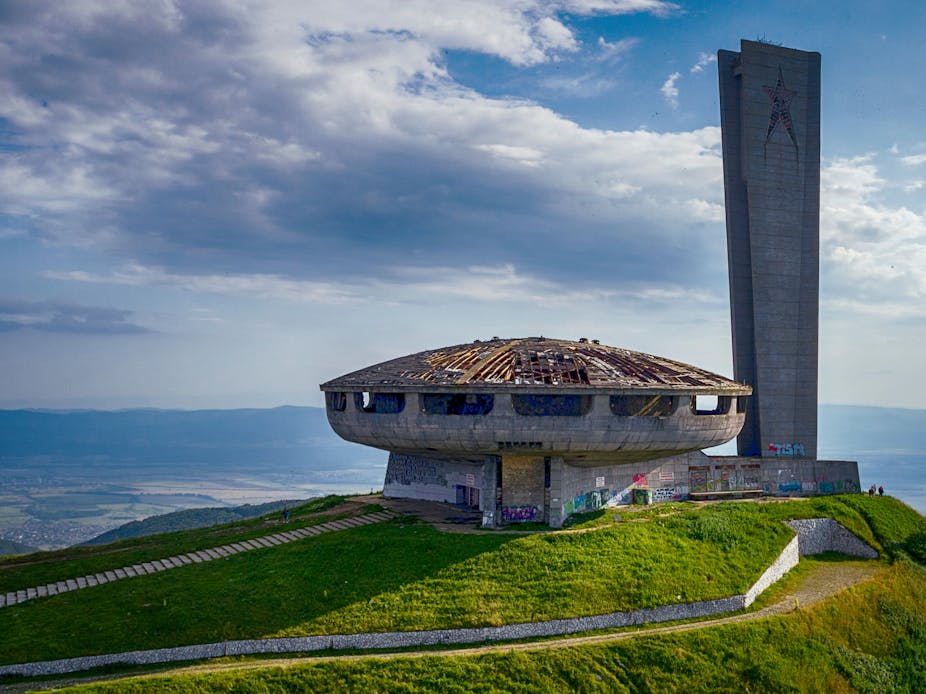All over the world, statues and monuments which celebrate controversial periods of history are being reconsidered and, in some cases, removed. In the US, for example, more than 100 Confederate memorials have been dismantled after becoming targets of protest and vandalism. But elsewhere, some attitudes about countries’ historical pasts are very different and, as my research in eastern Europe (specifically Bulgaria) has found, some people believe monuments which celebrate a history from which the world has moved on should be conserved.
There are thousands of monuments representing the Soviet and communist past in the countries formerly considered to be part of the Eastern Bloc. Bulgarian monuments in particular often celebrate fraternity and alliances (usually with Russia), and commemorate specific events such as World War II, or the liberation from the Ottoman Empire.
Some are monumental in size – such as the monument dedicated to the foundation of the Bulgarian state in the Shumen province, north-eastern Bulgaria – and sit in high and conspicuous locations, presiding over the surrounding landscape. Others stand quietly on the outskirts of sleepy towns and villages. The memorial for Dimitâr Blagoev, the founder of Bulgarian socialism, situated between the town of Kran and the Buzludzha peak in central Bulgaria, being one such example.

But since the fall of communism these buildings and statues have simply been abandoned, left to the mercy of the elements, and becoming victims of graffiti. Today, these monuments stand silent within Bulgaria’s developing cultural landscape. For the most part, they inspire a sort of ambivalence from Bulgaria’s population.
This attitude of neglect is beginning to change, however. In 2015, the Buzludzha Project was created with the aim of conserving the iconic Buzludzha monument. It seeks to explain, preserve and remember the building – which was once a functional event space and public museum – as well as the political context in which it was built and used.
Opened in 1981, the monument was created as a tribute to the socialist movement“, although Bulgarian society has since become democratic. The peak on which it was constructed is linked to three events which have great historical significance in the country too. These are the foundation of the Bulgarian Social Democratic Workers Party in 1891, the death of Hadzhi Dimitâr in 1868 (a military commander who fought for the liberation of Bulgaria from Ottoman rule) and a World War II-era battle between partisan and fascist forces.
Last month, the project attracted international investment in the form of US$185,000, from the American Getty foundation. This money was donated specifically for the restoration and renovation of Buzludzha as a heritage site.
But not all of the country’s communist monuments are as well known internationally as Buzludzha – and so have received little to no attention. Yet a critical factor that must be considered before any heritage site is created or restoration undertaken is the viewpoint of the country’s people. There is little point conserving a past they would rather forget.
To find out what the people of Bulgaria think of projects like this, I recently asked nearly 100 Bulgarians about the future of the country’s monuments. Using an online survey, I wanted to find out whether they wanted legislation to be implemented which aims to conserve and restore these monuments. I specifically asked whether they thought this should be an EU matter, rather than a state matter, due to the fact that Bulgaria does not currently have the funds needed to renovate and conserve all of its crumbling communist monuments.
Overall, the participants of the survey agreed that EU intervention is needed if these monuments are to be conserved (58% of respondents said they wanted it). Yet, while there was considerably divided opinion on this conservation point, the most interesting revelation from the survey was that most people considered these monuments to contribute to their sense of national identity. Even those under the age of 34 – the ones least likely to remember communism, if they lived through it at all – still felt connected to these places and recognised their role in maintaining aspects of national belonging. The monuments have become part of Bulgaria’s historical landscape and are now totems of intertwined real history and personal pasts.

While this is just a small survey, the fact that a majority of people would like to see Bulgaria’s monuments conserved is important. It may very well reflect national attitudes towards more conservation plans in line with what has been proposed for Buzludzha. More ventures like it would ultimately help to maintain Bulgaria’s monuments as important historical markers, in an environment which seeks to sustain the country’s national historic legacy.
Bulgaria’s monuments were born out of critical historical episodes which deserve to be memorialised. By recognising the importance of these structures to the Bulgarian people’s national psyche – regardless of age and political leaning – the EU and Bulgarian government will ensure that all citizens are represented within the diversification of the national story going forward into the 21st century.

